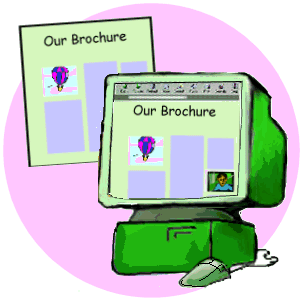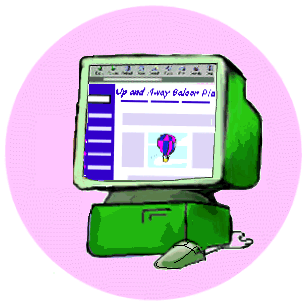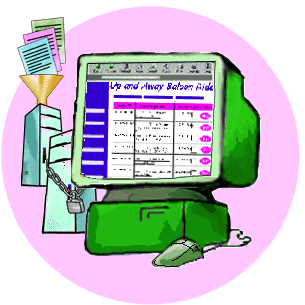 Back
Back| 3.2.1 3.2a Generations of Sites |
Over the last few years, the Internet and its graphical user interface,
the World Wide Web, has  gone from being a simple way to communicate to becoming a major distribution channel. The most drastic changes to the Internet has been how businesses and consumers
use these advances. As companies and users become more sophisticated, the
appearance of the Internet has changed. Initially companies were satisfied
to have a simple presence on the Internet. They took their existing brochures
and turned them into online Internet brochures. Since these brochures were
created to be distributed on paper, the results of a "brochure online"
web site were less then optimal. A brochure online web site is referred
to as a Generation 1 web site. The signs of a generation 1 web sites
are: content tends to be long and difficult to read online, the site is
clumsy and difficult to navigate, and it takes a long time to download
site information since the graphics were developed for print pieces, so
they tend to be very large. On a generation 1 site, there are few, if any
interactive, help, or support features.
gone from being a simple way to communicate to becoming a major distribution channel. The most drastic changes to the Internet has been how businesses and consumers
use these advances. As companies and users become more sophisticated, the
appearance of the Internet has changed. Initially companies were satisfied
to have a simple presence on the Internet. They took their existing brochures
and turned them into online Internet brochures. Since these brochures were
created to be distributed on paper, the results of a "brochure online"
web site were less then optimal. A brochure online web site is referred
to as a Generation 1 web site. The signs of a generation 1 web sites
are: content tends to be long and difficult to read online, the site is
clumsy and difficult to navigate, and it takes a long time to download
site information since the graphics were developed for print pieces, so
they tend to be very large. On a generation 1 site, there are few, if any
interactive, help, or support features.
As Internet usage grew, most companies changed and updated their web
sites. These updated sites became Generation 2 web sites. When upper
management became aware of the benefit of a web presence, they  tended to push their agenda. Generation 2 web sites tended to be internally focused.
Primary to a Generation 2 web site is information on investor relations,
mission statements, job openings, press releases, and messages from the
president. These topics are more appropriate for an Intranet (internal)
web site or for a limited side section of a corporate web site. Additionally,
Generation 2 web sites tend to be graphically heavy. Graphically heavy
features include click through pages (pages that provide no information,
just pretty graphics that the visitor needs to click on to get to information);
large product pictures that need to be viewed before the visitor can get
product information, and more than one flashing graphic per page. Navigation
on generation 2 sites tends to be cumbersome, since they deny visitors
quick access to information. Most visitors find it difficult to go directly
to where they want to go. Many web sites are currently generation 2 web
sites.
tended to push their agenda. Generation 2 web sites tended to be internally focused.
Primary to a Generation 2 web site is information on investor relations,
mission statements, job openings, press releases, and messages from the
president. These topics are more appropriate for an Intranet (internal)
web site or for a limited side section of a corporate web site. Additionally,
Generation 2 web sites tend to be graphically heavy. Graphically heavy
features include click through pages (pages that provide no information,
just pretty graphics that the visitor needs to click on to get to information);
large product pictures that need to be viewed before the visitor can get
product information, and more than one flashing graphic per page. Navigation
on generation 2 sites tends to be cumbersome, since they deny visitors
quick access to information. Most visitors find it difficult to go directly
to where they want to go. Many web sites are currently generation 2 web
sites.
The current state-of-the-art is Generation 3 sites. You know
you are on a generation 3 site by the  use of simple navigation elements including words or phrases used for navigation instead of graphics, and content that is focused on the visitor. Most Generation 3 sites use
a top and/or side navigation element. The navigation frames the sites content, leaving a center section for changing spotlighted items, product, services, and other forms of content. Visitors can reach the information in which they are interested within three clicks, without waiting for large graphics to download. Graphics tend to be small, non-animated, and used to highlight
the product. Text is used sparingly: this means it is found in short paragraphs or is bulleted. Internal Company information can be found on the site, but it is not spotlighted on the home page.
use of simple navigation elements including words or phrases used for navigation instead of graphics, and content that is focused on the visitor. Most Generation 3 sites use
a top and/or side navigation element. The navigation frames the sites content, leaving a center section for changing spotlighted items, product, services, and other forms of content. Visitors can reach the information in which they are interested within three clicks, without waiting for large graphics to download. Graphics tend to be small, non-animated, and used to highlight
the product. Text is used sparingly: this means it is found in short paragraphs or is bulleted. Internal Company information can be found on the site, but it is not spotlighted on the home page.
Generation 4 web sites are the future of the Internet. Generation
4 sites resemble generation 3 sites; the difference is behind the scenes.
Generation 4 sites are tightly integrated into all aspects of the company. When a customer looks for information on a Generation 4 site,
the information is generated from a database specifically for that customer.
For example, if you go to Amazon.com and perform a search on the word San Francisco,
a listing of all the books with "San Francisco" in the title
will be generated and displayed. Behind the scenes, Generation 4 sites
are very sophisticated. Additionally companies deploy technology to track customer buying patterns and provide customers with up-sell or complimentary purchases.
the company. When a customer looks for information on a Generation 4 site,
the information is generated from a database specifically for that customer.
For example, if you go to Amazon.com and perform a search on the word San Francisco,
a listing of all the books with "San Francisco" in the title
will be generated and displayed. Behind the scenes, Generation 4 sites
are very sophisticated. Additionally companies deploy technology to track customer buying patterns and provide customers with up-sell or complimentary purchases.